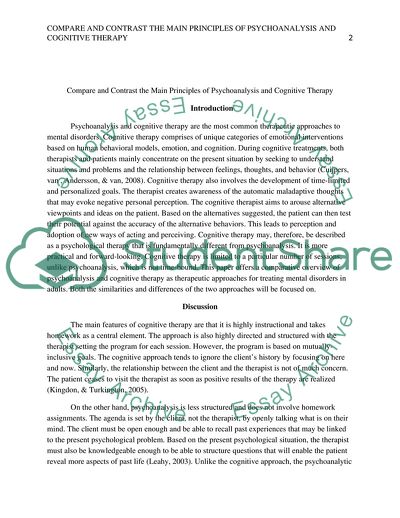Cite this document
(The Main Principles of Psychoanalysis and Cognitive Therapy Coursework Example | Topics and Well Written Essays - 1750 words, n.d.)
The Main Principles of Psychoanalysis and Cognitive Therapy Coursework Example | Topics and Well Written Essays - 1750 words. https://studentshare.org/psychology/1855593-compare-and-contrast-the-main-principles-in-any-two-of-the-following-psychological-therapies-psychoanalysis-behaviour-therapy-cognitive-therapy-or-humanistic-therapy
The Main Principles of Psychoanalysis and Cognitive Therapy Coursework Example | Topics and Well Written Essays - 1750 words. https://studentshare.org/psychology/1855593-compare-and-contrast-the-main-principles-in-any-two-of-the-following-psychological-therapies-psychoanalysis-behaviour-therapy-cognitive-therapy-or-humanistic-therapy
(The Main Principles of Psychoanalysis and Cognitive Therapy Coursework Example | Topics and Well Written Essays - 1750 Words)
The Main Principles of Psychoanalysis and Cognitive Therapy Coursework Example | Topics and Well Written Essays - 1750 Words. https://studentshare.org/psychology/1855593-compare-and-contrast-the-main-principles-in-any-two-of-the-following-psychological-therapies-psychoanalysis-behaviour-therapy-cognitive-therapy-or-humanistic-therapy.
The Main Principles of Psychoanalysis and Cognitive Therapy Coursework Example | Topics and Well Written Essays - 1750 Words. https://studentshare.org/psychology/1855593-compare-and-contrast-the-main-principles-in-any-two-of-the-following-psychological-therapies-psychoanalysis-behaviour-therapy-cognitive-therapy-or-humanistic-therapy.
“The Main Principles of Psychoanalysis and Cognitive Therapy Coursework Example | Topics and Well Written Essays - 1750 Words”. https://studentshare.org/psychology/1855593-compare-and-contrast-the-main-principles-in-any-two-of-the-following-psychological-therapies-psychoanalysis-behaviour-therapy-cognitive-therapy-or-humanistic-therapy.


